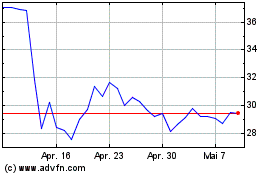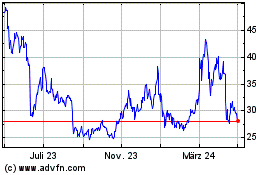How Bitcoin Phishing Scams Are Stealing Millions
29 August 2022 - 7:43PM
NEWSBTC
Phishing comes in many forms. The main target of any cybercrime is
to generate money from duplicitous actions. When a hacker targets
an international business and steals their data, there is a
financial incentive that pushes them to do so. As cryptocurrency
becomes a more recognized financial medium, attackers are actively
turning to target those with digital wallets. In 2021, crypto
scammers took $14 billion. Quite simply, as Bitcoin and other
cryptocurrencies become more valuable, they become a bigger target
for hackers and scammers. With this in mind, those that actively
buy, sell, and trade cryptocurrencies like Bitcoin need to be aware
of the risk they’re taking. In this article, to help reduce the
chance of you falling for a Bitcoin phishing scam, we’ve created
this article to show you the most common Bitcoin phishing messages
you’re likely to come across. By learning about which forms
phishing emails take, you’ll be better prepared to recognize them
and put a stop to them before anyone makes off with your
hard-earned crypto. What Are The Most Common Bitcoin Phishing
Scams? When creating phishing emails that cause cryptocurrency
owners to accidentally give away information about their private
wallets, the message often comes from a financial service. Whether
it’s an impersonation of a service or a fake exchange reaching out
via email, attackers use a range of strategies to try and deceive
their audience. When you open your inbox, try to scan for the
follow emails, as they might be a sign of someone attempting to
steal your information: Password resets Impersonation Fake
Exchanges Phishing Websites Scam Coins Let’s break down these
commonly-used methods. Password Resets Password resets are far from
exclusive to cryptocurrency scams, yet are still one of the most
pressing forms of scams that are employed when trying to steal
Bitcoin and another cryptocurrency. By copying the layout of an
email from an exchange like Binance, a hacker can duplicate a
password reset almost identically. They’ll send this email out,
alerting their victims that they need to reset their passwords.
Within this email, the reset link will then go to the attacker’s
own website, where they can then collect the old password and use
it to gain access to accounts. Especially with Bitcoin and other
cryptos, where a transaction is fairly irreversible, if a hacker
gains access to your account for even a few minutes, they can do
irreparable damage. It’s always a good idea to verify where your
password reset emails are coming from. Better still, only reset
your password by navigating from Google to the actual site, never
directly through an email itself. Impersonation Within the online
world, it’s incredibly easy to create fake profiles, find photos
online, and construct a whole false identity. Over the past few
months, the world of cryptocurrency has seen many false accounts
creating profiles, gaining an audience, hosting a scam giveaway,
then disappearing without a trace. Whether it be through private
messaging and asking for crypto or through hosting free giveaways
which inject malware onto computer systems, always double-check who
you’re talking to online. While an extreme form of impersonation,
back in 2020, a group of hackers managed to gain access to a
variety of notable figures on Twitter, such as Barack Obama, Jeff
Bezos, Kim Kardashian, and more. From these accounts, they then
tweeted a Bitcoin scam which saw Twitter users send over $110,000
USD in transactions. Always be wary about things that seem too good
to be true when it comes to crypto. Fake Exchanges Over the past 18
months, seemingly hundreds of DeFi exchanges have popped up. A
market that was once controlled by a few larger players is now
saturated by exchanges from all over the world. With this, it’s not
uncommon to find an email in your inbox that offers to help you
sell or buy Bitcoin at great rates. Unfortunately, many of these
emails will be phishing attempts, with the fake exchange simply
trying to farm information to take over a user’s wallet. Try and
stick to sites that you know are reputable, and always navigate to
them through Google instead of via email. Scam Coins While not
directly related to Bitcoin, throughout the history of blockchain,
a huge number of scam ICOs have been launched. This was at its
worst back in 2018, when 80% of all cryptocurrencies released
turned out to be scams. Investing in coins at a very early stage,
especially when the project seems to lack a great deal of
documentation, is not the smartest idea. Although it’s tempting
when you see promises of 100x returns, always be sure to research
any project thoroughly before you actually commit to investing.
Start with their white paper, read through their fundamentals and
tokenomics, and try to discern if this project is actually worth
investing in or just seems like hot air. Equally, if an email
arrives into your inbox that offers an airdrop in exchange for a
small Bitcoin fee – don’t leap at the opportunity. Airdrops should
never involve you giving away details of your account, no matter
how great the opportunity may seem to you on the outside. Remember
that phishing emails are incredibly common – you’re more likely to
come across a scam than a real crypto opportunity, unfortunately.
Final Thoughts Cryptocurrency, even in 2022, is still full of
scams, hacks, and people with bad intentions. Due to the huge value
of this industry, especially leading cryptos like Bitcoin,
attackers will stop at nothing to gain access to user wallets and
exploit them. When reading through your emails, you’re carefully
walking across the front lines, where the vast majority of
cryptocurrency scams and exploits occur. What may seem like a
simple email might actually have much worse intentions. Be sure to
always take your time, read carefully, and never click on links
from companies that you don’t recognize – your Bitcoin could be at
stake.
Dash (COIN:DASHUSD)
Historical Stock Chart
Von Mär 2024 bis Apr 2024

Dash (COIN:DASHUSD)
Historical Stock Chart
Von Apr 2023 bis Apr 2024
